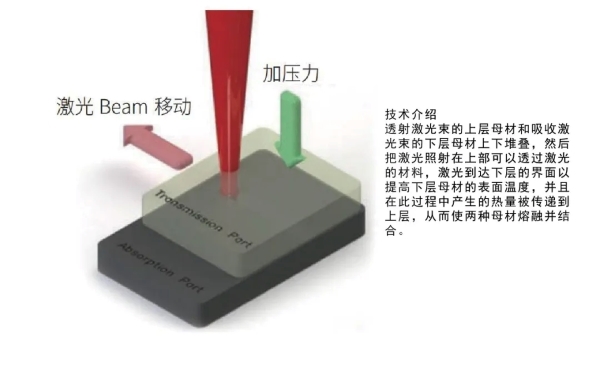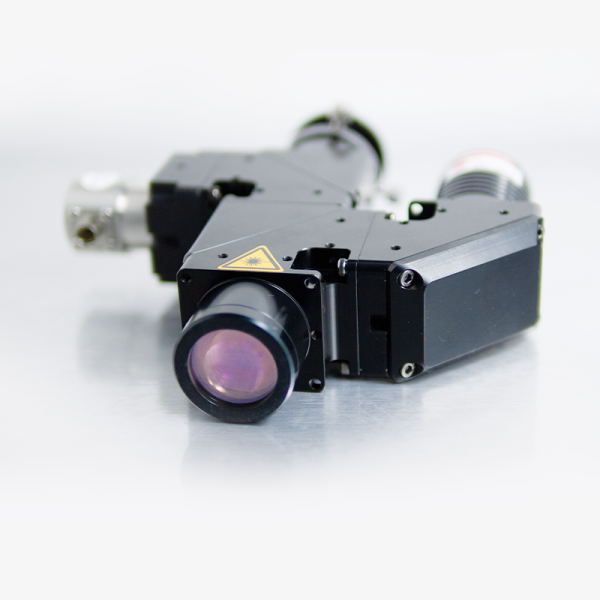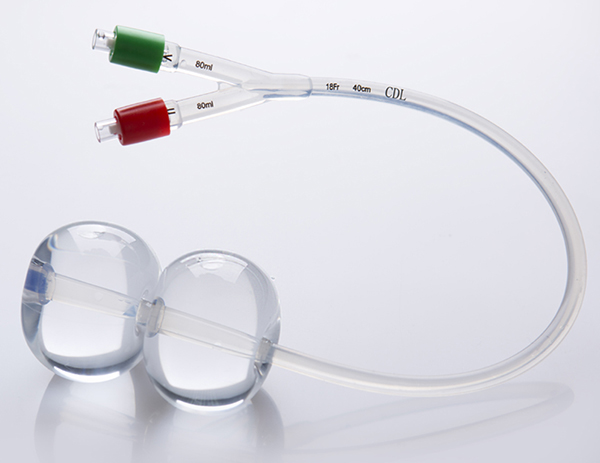Advantages and Applications of 2μm Laser Plastic Welding
Principle of Laser Plastic Welding
The principle of laser plastic welding is based on the high energy density of laser beams and their transmission characteristics in materials. The process involves stacking an upper layer (transparent to the laser) and a lower layer (absorptive to the laser). When the laser irradiates the upper layer, the beam penetrates it and reaches the interface of the lower layer. The absorbed laser energy raises the surface temperature of the lower material, generating heat that transfers to the upper layer, causing both materials to melt and fuse (see diagram below).

Schematic Diagram of Laser Plastic Welding Principle
Advantages of Laser Plastic Welding
Current plastic welding methods in the market mainly include hot plate welding, hot gas welding, ultrasonic welding, thermal rod and pulse welding, and resistance implant welding. These methods present numerous limitations in terms of welding precision, dimensional control, efficiency, and reliability that urgently need improvement. The market demands a rapid welding solution that can both control thermoplastic deformation to enhance processing accuracy and ensure uniform weld seams for superior quality.
To meet these needs, laser plastic welding has emerged. Compared with traditional welding methods, it offers the following advantages:
Non-Contact Welding:
Laser welding is a non-contact process, eliminating mechanical stress and vibration issues inherent in conventional methods, thereby preserving the structural integrity and performance of plastic components.
High Precision & Superior Weld Quality:
The 2μm laser wavelength and spot size are ideal for plastic absorption and welding, enabling ultra-fine welds through beam shaping. Additionally, concentrated heat input and a small heat-affected zone (HAZ) produce clean seams with minimal thermal distortion.
Broad Material Compatibility:
The 2μm laser accommodates diverse plastics including polyethylene (PE), polypropylene (PP), and polyvinyl chloride (PVC).
Automation & Complex Geometry Adaptability:
Programmable 2μm laser systems with automated controls minimize human intervention, boosting productivity and consistency. The technology excels in non-planar applications like connectors, curved components, and pipe joints, achieving flawless complex welds.
Eco-Friendliness & Safety:
Unlike traditional methods requiring gases, wires, or adhesives, 2μm laser welding only needs additives (e.g., fillers/pigments) to enhance laser absorption, reducing environmental impact and safety hazards.

Image of Songhsheng Optoelectronics 2μm Coaxial Temperature-Measurement Imaging Plastic Laser Welding Head
The 2μm laser wavelength from Songsheng Optoelectronics demonstrates excellent absorption with many polymer materials, making it the ideal choice for plastic welding applications. The integrated coaxial infrared temperature measurement provides real-time feedback to the control system, enabling dynamic adjustment of laser parameters to maintain consistent welding temperature - ensuring optimal weld quality and maximum production yield.
Key Features:
Closed-loop temperature control system
Ultra-precise weld seams
Coaxial CCD monitoring interface
Compact, rugged and fully sealed design
Integrated coaxial laser, temperature measurement and imaging
Maintenance-free operation with no additional adjustment mechanisms
Designed for high-intensity automated production environments
This advanced welding head combines three critical functions in one coaxial optical path (laser delivery, temperature monitoring and visual imaging) to deliver reliable, high-quality plastic welding performance while meeting the demands of modern automated manufacturing systems.
Specific Applications of Laser Plastic Welding
Currently, 2μm laser plastic welding technology has been widely applied in various fields including medical and electronic industries due to its high efficiency, precision and environmental friendliness.
In the medical field: 2μm laser plastic welding technology plays a significant role in medical device manufacturing. It can be used for welding capsule housings of endoscopic capsules, blood analyzers, microfluidic control devices, disposable infusion equipment, and medical electronic device tubing. This technology can replace traditional adhesive bonding methods, specifically designed for welding plastic products in the medical field. It requires no flux, provides high welding strength and stable performance. Currently, precision medical devices including cardiac stents, gastroscopic biopsy forceps, earwax protectors, and balloon plastic catheters commonly adopt laser welding processing methods.
Particularly for balloon plastic catheters, as a plastic medical interventional device for treating upper gastrointestinal stricture dilation, laser welding processing is now widely used. For processing balloon catheters, the 2μm laser beam is directly irradiated onto the laser-absorbing plastic surface to melt the plastic for welding. Advanced laser welding technology can achieve seamless connection between the balloon tip and catheter body, enabling smooth advancement of the balloon catheter through curved and narrow diseased blood vessels with minimal vascular damage and safer operation. In the future, the introduction of more advanced laser welding technology is expected to further reduce the outer diameter of balloon dilation catheter tips.

Illustration of Balloon Plastic Catheter
Electronics Industry: In the precision plastic electronics sector where miniaturization and lightweight are key, 2μm laser plastic welding technology has found extensive applications. For instance, it can be used for welding plastic components in computers, mobile phone parts (such as casings, earphone jacks, USB ports), mice, connectors, switches and other plastic components.
Automotive Industry: With the rapid development of the automotive sector, particularly driven by new energy vehicle manufacturers, the market urgently requires high-precision, high-quality, high-efficiency and environmentally friendly automotive component processing technologies. 2μm laser plastic welding technology can meet various automotive component connection needs, including headlights, dashboards, sensors, micro-motors, radars, and cameras. This technology ensures both high efficiency and quality in connections while fulfilling the automotive industry's demand for pollution-free production.
Home Appliance Industry: In home appliance manufacturing, 2μm laser plastic welding technology also boasts broad applications. Components such as washing machine and refrigerator casings, control panels can all utilize this connection technology. The method not only enhances production efficiency but also guarantees product quality stability and reliability.
Furthermore, with continuous technological advancements and market expansion, 2μm laser plastic welding technology may find applications in more fields such as aerospace and toy manufacturing. In summary, with its advantages of high precision, efficiency and pollution-free operation, 2μm laser plastic welding technology is becoming the preferred plastic welding solution for an increasing number of industries.
Contact: Mr.Xiao
Phone: +86-13385280662
E-mail: market001@whlaser.cn
Add: Room 02, Floor 5, Building 9, Gezhouba Sun City, No. 40, Gaoxin 4th Road, Donghu New Technology Development Zone, Wuhan